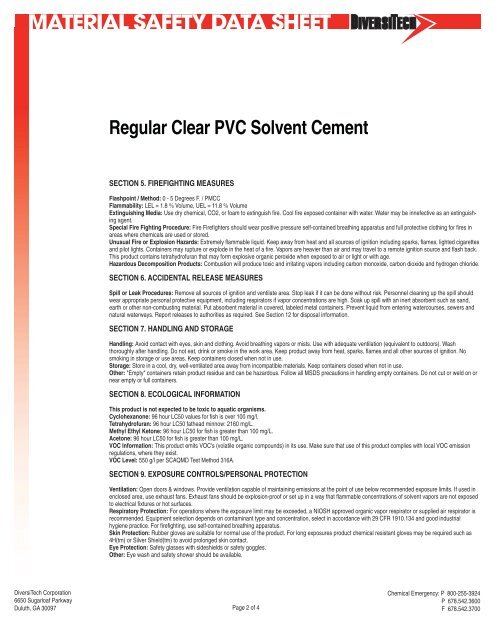Print MSDS - Miller Electric Company Publications
Print MSDS - Miller Electric Company Publications
Print MSDS - Miller Electric Company Publications
Create successful ePaper yourself
Turn your PDF publications into a flip-book with our unique Google optimized e-Paper software.
MATERIAL SAFETY DATA SHEET<br />
DiversiTech Corporation<br />
6650 Sugarloaf Parkway<br />
Duluth, GA 30097<br />
Regular Clear PVC Solvent Cement<br />
SECTION 5. FIREFIGHTING MEASURES<br />
Flashpoint / Method: 0 - 5 Degrees F. / PMCC<br />
Flammability: LEL = 1.8 % Volume, UEL = 11.8 % Volume<br />
Extinguishing Media: Use dry chemical, CO2, or foam to extinguish fire. Cool fire exposed container with water. Water may be innefective as an extinguishing<br />
agent.<br />
Special Fire Fighting Procedure: Fire Firefighters should wear positive pressure self-contained breathing apparatus and full protective clothing for fires in<br />
areas where chemicals are used or stored.<br />
Unusual Fire or Explosion Hazards: Extremely flammable liquid. Keep away from heat and all sources of ignition including sparks, flames, lighted cigarettes<br />
and pilot lights. Containers may rupture or explode in the heat of a fire. Vapors are heavier than air and may travel to a remote ignition source and flash back.<br />
This product contains tetrahydrofuran that may form explosive organic peroxide when exposed to air or light or with age.<br />
Hazardous Decomposition Products: Combustion will produce toxic and irritating vapors including carbon monoxide, carbon dioxide and hydrogen chloride.<br />
SECTION 6. ACCIDENTAL RELEASE MEASURES<br />
Spill or Leak Procedures: Remove all sources of ignition and ventilate area. Stop leak if it can be done without risk. Personnel cleaning up the spill should<br />
wear appropriate personal protective equipment, including respirators if vapor concentrations are high. Soak up spill with an inert absorbent such as sand,<br />
earth or other non-combusting material. Put absorbent material in covered, labeled metal containers. Prevent liquid from entering watercourses, sewers and<br />
natural waterways. Report releases to authorities as required. See Section 12 for disposal information.<br />
SECTION 7. HANDLING AND STORAGE<br />
Handling: Avoid contact with eyes, skin and clothing. Avoid breathing vapors or mists. Use with adequate ventilation (equivalent to outdoors). Wash<br />
thoroughly after handling. Do not eat, drink or smoke in the work area. Keep product away from heat, sparks, flames and all other sources of ignition. No<br />
smoking in storage or use areas. Keep containers closed when not in use.<br />
Storage: Store in a cool, dry, well-ventilated area away from incompatible materials. Keep containers closed when not in use.<br />
Other: "Empty" containers retain product residue and can be hazardous. Follow all <strong>MSDS</strong> precautions in handling empty containers. Do not cut or weld on or<br />
near empty or full containers.<br />
SECTION 8. ECOLOGICAL INFORMATION<br />
This product is not expected to be toxic to aquatic organisms.<br />
Cyclohexanone: 96 hour LC50 values for fish is over 100 mg/l.<br />
Tetrahydrofuran: 96 hour LC50 fathead minnow: 2160 mg/L.<br />
Methyl Ethyl Ketone: 96 hour LC50 for fish is greater than 100 mg/L.<br />
Acetone: 96 hour LC50 for fish is greater than 100 mg/L.<br />
VOC Information: This product emits VOC's (volatile organic compounds) in its use. Make sure that use of this product complies with local VOC emission<br />
regulations, where they exist.<br />
VOC Level: 550 g/l per SCAQMD Test Method 316A.<br />
SECTION 9. EXPOSURE CONTROLS/PERSONAL PROTECTION<br />
Ventilation: Open doors & windows. Provide ventilation capable of maintaining emissions at the point of use below recommended exposure limits. If used in<br />
enclosed area, use exhaust fans. Exhaust fans should be explosion-proof or set up in a way that flammable concentrations of solvent vapors are not exposed<br />
to electrical fixtures or hot surfaces.<br />
Respiratory Protection: For operations where the exposure limit may be exceeded, a NIOSH approved organic vapor respirator or supplied air respirator is<br />
recommended. Equipment selection depends on contaminant type and concentration, select in accordance with 29 CFR 1910.134 and good industrial<br />
hygiene practice. For firefighting, use self-contained breathing apparatus.<br />
Skin Protection: Rubber gloves are suitable for normal use of the product. For long exposures product chemical resistant gloves may be required such as<br />
4H(tm) or Silver Shield(tm) to avoid prolonged skin contact.<br />
Eye Protection: Safety glasses with sideshields or safety goggles.<br />
Other: Eye wash and safety shower should be available.<br />
Page 2 of 4<br />
Chemical Emergency: P 800-255-3924<br />
P 678.542.3600<br />
F 678.542.3700



